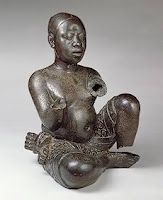Scribes were students before they were teachers. During each phase of learning, receiving knowledge, and teaching, giving knowledge, there were particular "stances" one would take to align the brain in the most optimal position for what it was about to receive. We see these poses today in the statues of ancient KMT and the writings on the walls. But you know what, scribes exist cross culturally, not just in Africa. Some believe writing developed independently by different cultures separately. There was no school that the first writers went to in each culture....because they all had no contact until Columbus, remember? In America we celebrated Columbus Day this week, which originally was October 12, 1492, and the children were given an excused absence from school. It is a federal holiday honored by the school system where children are not compelled to learn to read and write and the like. So imagine a world, shall we, where the human race scattered across the globe uncivilized and remained as such until each independently developed their own civilization elements. Why is this important to the Egyptian Goddess Seshat whose imagery spans a history of over 7,000 years? Let's look at the 8 litmus test in which scholars determine who was and was not civilized.
This pose, called the Madonna, as well as the seated position in lotus and with one leg raised is found among the Chinese, Lakota, Australia, South America and more. What I've come to recognize is that the older something is the more applicable it is to more cultures. The history of Seshat goes back beyond Narmers palate and the early cultures in Africa 7,000 years ago.
- They had to have a writing system
- They need to have used a complex government- Law
- The complex government should supply public works to the people, like bridges and irrigation..benefits to all.. check out the Merinda culture 5000BC (stretching-of-the-rope technology to produce lines and angles in the land)
- They need to have artisans and specialized jobs... check out the Badarian culture of 4400BC and the legendary god Ptah, master of crafts.

Naqada I /Lapis Sight 
Ptah/ Lapis Skald Cap 
Ptah / Agriculture/Green god - Complex religion. "The earliest known shrines appeared in Egypt in the late Predynastic Period, in the late fourth millennium BC, at sites such as Sais and Buto in Lower Egypt and Nekhen and Coptos in Upper Egypt." (Wiki)

Luxor Temple 
Sem Priest in Temple 
Sem Priest or Priest of Seshat 

Sem Priest/Zulu Priest
- Farmers along river valleys to support the growth of cities
- Architecture

Mexican Hut 
Early America 
Ancient Egypt 2600BC+
- They need to have a social class in which they separate groups of people based off their connection to the specialized jobs
So for me taking into considering the elements of the early culture of people who thrived from writing and the laying of the land to produce specializations and support large city states I get all warm inside when I see scribal poses cross culturally. Particularly, when I see they coincide with the first temples, and farmers, and artist, and irrigation, and the color blue, and large populations along rivers of any given culture. Common threads and elements that to me or too much alike to be considered to have developed independently. So Columbus I am sorry but I dont think you chartered the first boat to the Americas and the education break for this day really should be put in its proper perspective in our school systems.
So, enough about cultural continuity and "civilized" folks, who were the we ancients modeling in art? Who was the wet nurse? what did it signify? Why is our galaxy the Milky Way? Why do we have a thirst for knowledge? I mean really, should all cultures who build mounds and write create their own breast feeding mother in art? Why is the act of breastfeeding created in art in similar ways as the scribal poses and prayer stances? Whats this all about?? Do we really believe its about momma feeding little Johnny Appleseed colostrum? Did the ancients create permanent art and put this act in the temples, building, graves, ect for reverence to their mother when they were a child? I mean, what explanation are we really given for this cross cultural phenomena?
My first inclination when I started to study Seshat and read a play in the book of Thoth, in which the one-who-loves-knowledge in the script says his line about how he thirst for her and calls to her for him to suckle at her breast. This made me think that maybe the statues of Isis and the like are really just another version or aspect of Seshat during that phase of the scholars reverence to their educational path. Not a different person, but a different recognition in the eyes of the artist to a goddess with many favorable things to acknowledge. But even if Seshat is not all of these goddesses with different headdresses and titles in one, she certainly contained the image of the woman who breastfed the ancient Africans in their quest to become knowledgeable. Knowledgeable about math, architecture, astronomy, agriculture, medicine, and divinity.
Last month I drove to Cahokia Mounds in St Louis after visiting another ancient pyramid site in Evansville, Indiana while visiting the casino. I saw this statue of a figure with a bended knee, which I recognized as a scribal pose, breastfeeding.
My first inclination when I started to study Seshat and read a play in the book of Thoth, in which the one-who-loves-knowledge in the script says his line about how he thirst for her and calls to her for him to suckle at her breast. This made me think that maybe the statues of Isis and the like are really just another version or aspect of Seshat during that phase of the scholars reverence to their educational path. Not a different person, but a different recognition in the eyes of the artist to a goddess with many favorable things to acknowledge. But even if Seshat is not all of these goddesses with different headdresses and titles in one, she certainly contained the image of the woman who breastfed the ancient Africans in their quest to become knowledgeable. Knowledgeable about math, architecture, astronomy, agriculture, medicine, and divinity.
Last month I drove to Cahokia Mounds in St Louis after visiting another ancient pyramid site in Evansville, Indiana while visiting the casino. I saw this statue of a figure with a bended knee, which I recognized as a scribal pose, breastfeeding.
 |
| MIDDLE TO LATE MISSISSIPPIAN PERIOD ILLINOIS, INDIANA & KENTUCKY Flourite: 3 right knee up, second statue is in Lotus position with beaded forelock found off Ohio River |
 |
| Etowah Cartersville, GA North America Found at Pyramid Site |
 |
| Sandy 1250AD Tennessee State Artifact Sellars Farm, Lebanon, TN pyramid site |
 |
| Scribal position with tools |
This pose, called the Madonna, as well as the seated position in lotus and with one leg raised is found among the Chinese, Lakota, Australia, South America and more. What I've come to recognize is that the older something is the more applicable it is to more cultures. The history of Seshat goes back beyond Narmers palate and the early cultures in Africa 7,000 years ago.





















